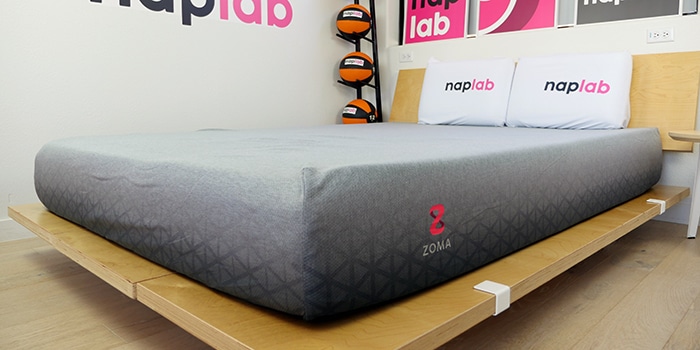
Best For
- Budget option, Queen under $700
- Excellent edge support
- Higher levels of bounce are optimal for good sex performance
Considerations
- A thinner comfort layer may not provide enough pressure relief for heavier sleepers
- Higher levels of motion transfer may not be ideal for sensitive sleepers
Our Verdict
The Zoma Start mattress is a budget-friendly all-foam mattress with a medium-firm feel. It has a 10″ profile, 2″ less than the Zoma All-Foam mattress.
The mattress has very minimal sinkage and slightly higher levels of bounce, which gives it a more floating feeling as opposed to an enveloped one. It will also be easier to move around on.
The mattress only comes in a single firmness option that is a medium firm 6.5 out of 10.
The Zoma Start has a performance score of 8.56, ranking it in the bottom 42% of all mattresses tested to date.
A queen-size Zoma Start will cost $636, which is a savings of $827 (or 57%) compared to the average mattress price. So if the drawbacks aren’t deal breakers for you, the Start can mean big savings.
Type: Foam
Firmness: Medium-Firm (6.5)
Best For: All Sleeping Positions, Sleepers Under 250 lbs.
In This Review
Performance Tests | Firmness | Support & Sleeping Positions | Design | Materials | Comparisons | FAQs
Performance Tests
At NapLab, we put each mattress to the test.
We test 10 different factors that impact the performance, comfort, and value of the mattress. We then take the results of that test and compare to every mattress we’ve tested to date.
Check out the full performance table below to see how this mattress ranks:
| Factor | Zoma Start | Average |
|---|---|---|
| Overall Score | 8.56 | 8.55 |
| Price (Queen) | $636 | $1,133 (Foam only) |
| Cooling – Score | 8.0 | 8.7 |
| Sinkage – Depth | 1.73″ | 2.15″ |
| Sinkage – Feel | Minimal | Moderate |
| Motion Transfer – Score | 8.0 | 8.2 |
| Motion Transfer – Acceleration | 9.35 m/s² | 8.80 m/s² |
| Response Time – Score | 9.4 | 8.9 |
| Response Time – Mostly Recovered | 0.3 sec. | 0.4 sec. |
| Response Time – Fully Recovered | 0.5 sec. | 0.9 sec. |
| Bounce – Height | 10.37″ | 9.50″ |
| Bounce – Feel | High | Moderate |
| Edge Support – Score | 9.5 | 8.6 |
| Edge Support – Sitting | 3.00″ | 4.05″ |
| Edge Support – Lying | Excellent | Good |
| Sex – Score | 9.2 | 8.4 |
| Pressure Relief – Score | 8.0 | 8.7 |
| Comfort Layer Thickness | 2.0″ | 4.1″ |
| Mattress Thickness | 10″ | 12.0″ |
| Off-Gassing – Score | 8.9 | 8.2 |
| Off-Gassing – Smell | Strong | Strong |
| Off-Gassing – Days | 4 days | 6 days |
| Company – Score | 9.0 | 8.8 |
| Trial | 100 nights | 176 nights |
| Warranty | 10 years | 25% have lifetime warranties, average of other 75% of mattresses is 13 years |
How is Zoma Start Different?
The Zoma Start has a perfectly average overall performance, but also a price tag that is significantly lower than average too—over 42% less than the average foam mattress for a savings of over $450 ($827 compared to all mattress types) for a queen mattress.
Advantages
Besides cost advantages, other perks to the Zoma Start include faster material response time, 26% better edge support, better sex performance, and slightly faster off-gassing.
Neutral Factors
This mattress has minimal sinkage (20% less than the average mattress) and slightly more bounce than average (9% greater). Both sinkage and bounce fall within a normal range and may be more of a personal preference.
Disadvantages
Disadvantages include slightly poorer cooling performance, 10% higher levels of motion transfer, and a shorter trial period (76 nights shorter than average). This mattress only has 2.0″ of comfort material so heavier sleepers may experience pressure relief issues or inadequate support as well.
Cooling Test
The Zoma Start has a good, but not amazing cooling performance. In our tests, I felt a slight level of heat retention building up around my body. It was nothing dramatic, but it was also enough to be noteworthy.
Baseline Temp.
78.1° F
Max Temp.
88.4° F
Ending Temp.
81.0° F
The simple all-foam design keeps the price in check, but it doesn’t do much for improved cooling. There are no major cooling features or cooling design elements. No phase change material, no coils for breathability, and no convoluted foam layers.
Max Temp.
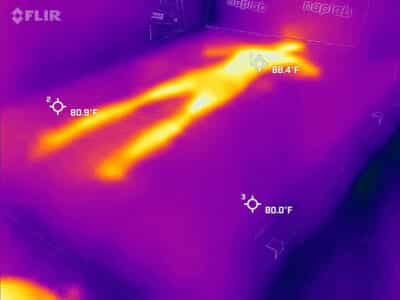
Ending Temp
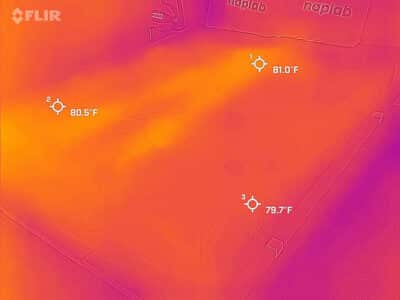
- Baseline Temperature – the temperature of the mattress before anyone lies on it
- Maximum Temperature (0 minute) – the temperature of the mattress after lying on it for 15 minutes
- Ending Temperature (5 minute) – the temperature of the mattress after being lied upon and having no one on it for 5 minutes
The top comfort layer is gel-infused, which is something at least. Even so, it’s not a miracle worker when it comes to cooling. If you’re a hot sleeper you’ll probably be better off with the Zoma Hybrid.
Looking at our objective data we recorded a max temperature of 88.4° F, which is 1.0° cooler than average. Heat dissipation was also better than average at each interval, declining 4.1° from minutes 0 to 1 and 7.4° from minutes 0 to 5.
Heat Dissipation Over Time
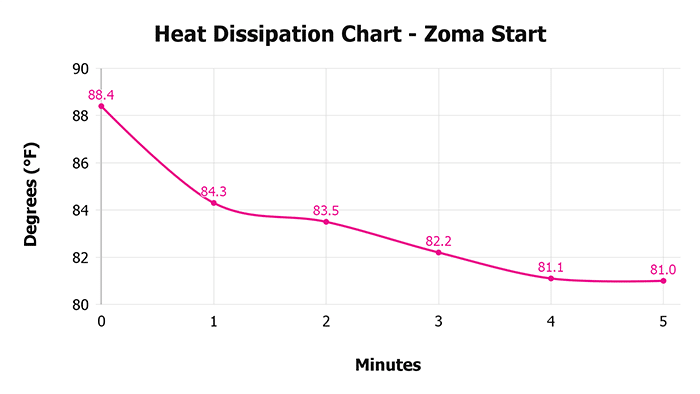
While the objective data indicates a cooler-performing mattress, in my view, my subjective experience on the mattress and my assessment of the material layers hold more weight in determining the cooling score for Zoma.
Zoma’s Start is good for cooling, but don’t expect any miracles. Furthermore, if you’re a naturally hot sleeper you should consider a hybrid instead.
Sinkage Test
The Zoma Start has a minimal level of sinkage. In our tests, we measured a pressure point sinkage depth of 1.73”. This is 0.42” less sinkage than the average of 2.15” (based on all of our tests to date).
Sinkage Depth
1.73″
Sinkage Feel
Minimal
Body Contour
Slight
The level of sinkage is documented in the image below.
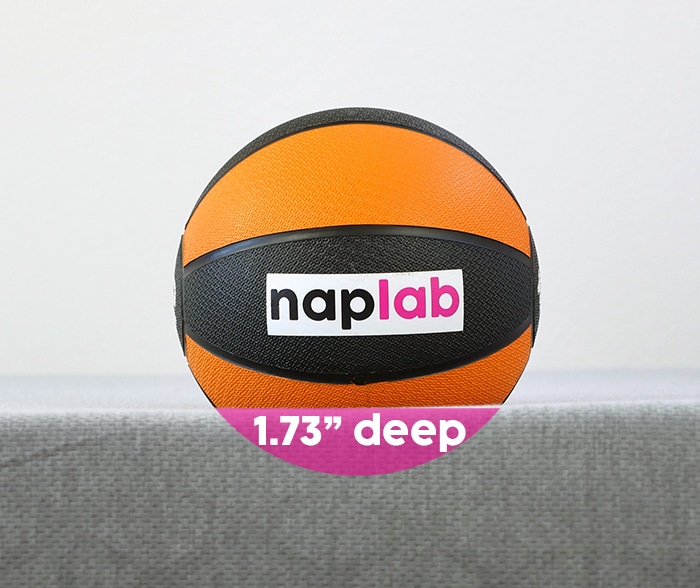
The mattress has a more restrained level of contour around the body. While the top layer is memory foam, which will create a more significant hug around your exact shape, it’s limited to just 1.0”.
There’s an additional 1.0” of poly foam as a transitional layer, bringing the total to 2.0” of comfort foam. However, by any standard, this is a thin comfort layer.
The thinness without question helps keep the price in check, but by its nature creates a more restrained type of body contour. In general, the sinkage around my body feels minimal.
When under more significant pressure we see moderate levels of sinkage depth. There is more of a “floating on top” of the mattress feel as opposed to sinking down “in the mattress”.
Motion Transfer Test
The Zoma Start has a low level of motion transfer. In our tests, we measured 9.35 m/s² of acceleration range. This is 6.3% more motion transfer than the average of 8.80 m/s².
Accel. Range
9.35 m/s²
Motion Duration
0.78 seconds
The level of motion transfer is documented in the video below.
Mattresses with a thinner comfort layer often have more motion transfer. This is because the comfort layer isn’t able to absorb as much of the energy. As a result, the firmer support layer rebounds more of the energy, creating more motion transfer.
While less motion transfer is always better, given the price point, I’m not terribly worried about the moderate motion we measured here.
The motion transfer chart, which visualizes our accelerometer data, confirmed a fairly typical motion duration.
There’s a high level of motion from 0.00 to 0.14 seconds. Moderate motion persists up until 0.78 seconds, before returning to near zero levels.

Mattresses with the lowest motion are able to disperse all energy within 0.3 seconds. Zoma Start isn’t at that level, but the motion duration is still relatively restrained.
Many other types of mattresses, especially latex and hybrid mattresses, can have moderate motion persist for 1.0-1.5 seconds.
Motion Transfer Over Time

Response Test
The Zoma Start has a very fast response time. In our tests, we measured a mostly recovered response time of 0.3 seconds and a fully recovered response time of 0.5 seconds.
Mostly Recovered
0.3 sec.
Complete Recovery
0.5 sec.
This is faster than the average. Based on all of our tests to date, on average, we have measured a mostly recovered response time of 0.4 seconds and an average fully recovered response time of 0.9 seconds.
The level of responsiveness is documented in the video below.
Zoma’s comfort layer rebounds extremely quickly, most likely due to a combination of relative thinness and a more modern memory foam formulation.
The faster response time helps ensure sleepers don’t feel stuck, eases movement, and improves sex.
Bounce Test
Zoma Start has a very high level of bounce. In our tests, we measured 10.37” of total bounce height. This is 0.87″ bounce than the average of 9.50” (based on all of our tests to date).
Max. Depth
5.31″
Max. Rebound
5.06″
Total Bounce
10.37″
Max. Sinkage Depth
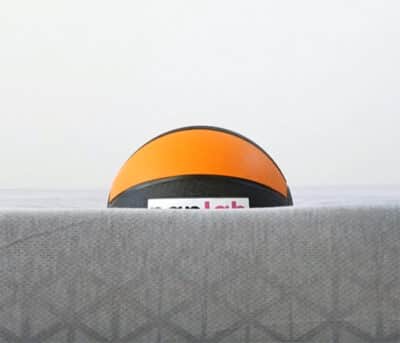
Max Bounce Height
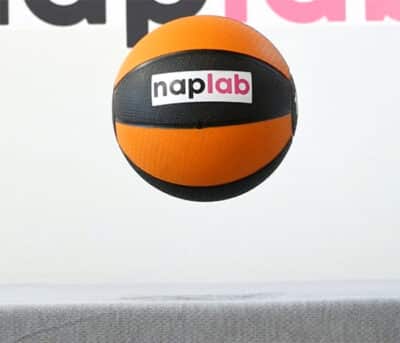
The level of bounce is also documented in the video below.
In general, I like to see bounce in the 8-12” range. It’s enough to improve ease of movement and sex, while not being so high as to create significant issues with motion transfer or a trampoline feel.
Zoma Start is right in the sweet spot. I expect most sleepers will find the level of bounce to be satisfactory.
Edge Support Test
The Zoma Start has outstanding sitting edge support and excellent lying edge support. In our sitting edge support tests, we measured a sitting sinkage depth of 3.0”. This is significantly better than the average of 4.05” of sitting edge compression.
Max. Sinkage
3.00″
Lying Support
Excellent
Reinforced Edge
No
The level of edge support while seated is documented in the images below.
When sitting directly at the edge, less sitting sinkage is better as it means the edge of the mattress is more supportive for direct edge-of-mattress activities (getting dressed, watching tv, intercourse, etc.)
Sitting, 140 lbs.

Sitting, 200 lbs.
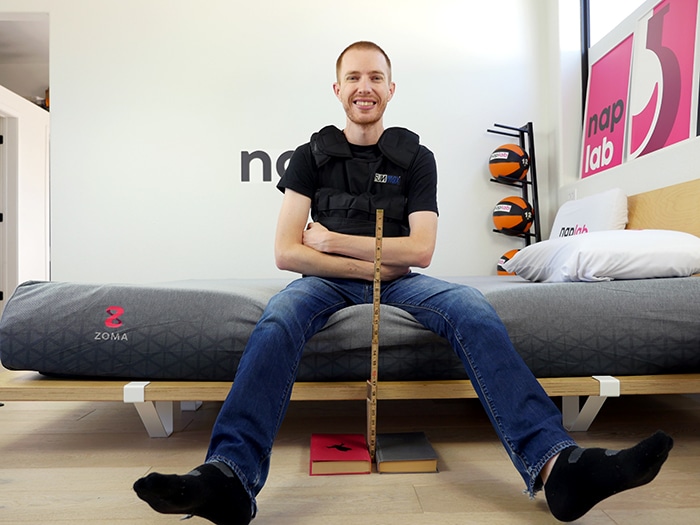
Likewise, lying edge support was also impressive. I felt well-supported in all sleeping positions, even when lying directly on the edge of the mattress.
The level of edge support while lying is documented in the images below.
Lying on Edge, 140 lbs.
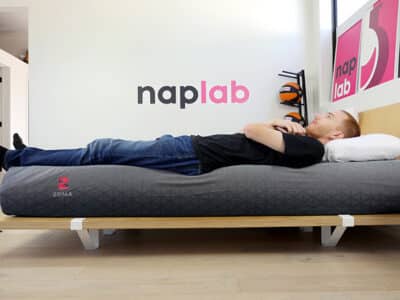
Lying on Edge, 200 lbs.
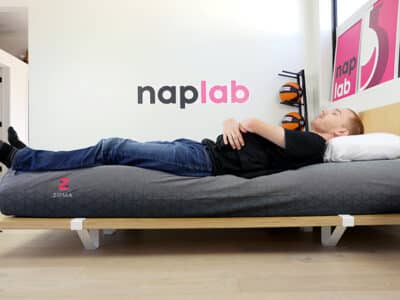
The thinner comfort layer, while less than great for pressure relief, does help to improve edge support. With the thinner comfort layer, you engage more immediately with the firmer support layer, which ensures that your body gets plenty of support when lying even on the absolute edge.
Sex Test
The Zoma Start has excellent sex performance with little room for improvement.
These 5 factors make up the NapLab sex performance score.
| Sex Factor | Factor Weight | Score | Rating |
|---|---|---|---|
| Bounce | 65% | 9.0 | Very High |
| Edge Support | 20% | 10 | Outstanding |
| Noise | 5% | 10 | Minimal |
| Pressure Relief | 5% | 8.0 | Good |
| Cooling | 5% | 8.0 | Good |
This is an exceptional score and really shows how Zoma shines in this category. The Zoma Start has excellent edge support and high levels of bounce. These two factors alone make up 80% of the sex score.

Other performance factors include a quiet surface, good (but not great) pressure relief, and good cooling as well.
Overall, this really checks all of the boxes we look for in this category.
Pressure Relief Test
The Zoma Start has good, but not great pressure relief. In our tests, I felt a moderate building of pressure points, especially while lying on my back.
Comfort Layer
1.0″
Support Layer
9.0″
My neck and upper back in particular felt a more noted level of pressure. With only 2.0” of comfort foam, there is just only so much that a mattress like this can do.
Even relatively lightweight sleepers such as myself (140 pounds) will sink through much of the 2.0” of comfort material and into the less pressure relieving support foams.
This is what will create more pressure, especially for heavier-weight bodies and side sleepers.
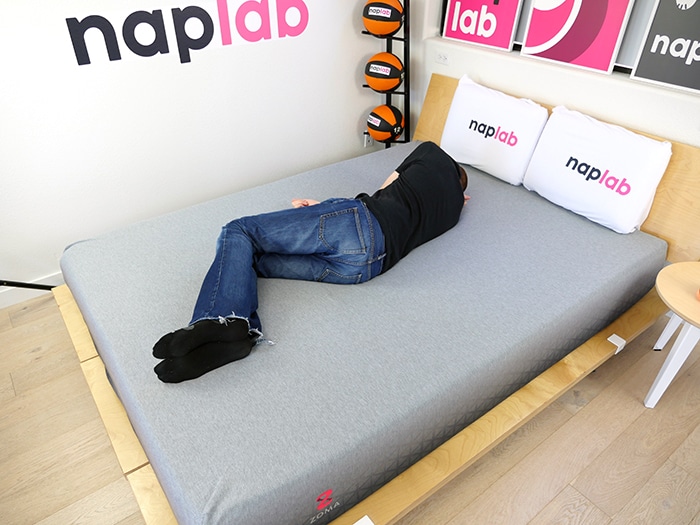
For back and stomach sleepers it should be less of an issue, as those positions can do well with less pressure relief and increased firmness. However, side sleepers in particular may find pressure relief to be lacking.
Zoma Start is designed to be a more budget-friendly mattress. As a result, you get a thinner comfort layer. If you’re heavier and/or a side sleeper you may simply need to spend a little more money to get a mattress with a thicker comfort layer to better support your body’s needs.
Off-Gassing Test
Off-gassing on the Zoma Start wasn’t too surprising. Out of the box, the mattress had a strong smell that lasted for 4 days.
Initial Smell Strength
Strong
Off-Gassing Period
4 days
Compared to the average, this is a little less, but not by much. The average across all mattresses we’ve tested to date is approximately 6-7 days. The good news about off-gassing is that once the process is complete, it’s complete for the entire life of the mattress.
Company
The company score takes a look at factors that may influence your experience with the mattress.
Factors include length of the trial period, warranty, shipping / return costs, and country of origin.
| Company Factor | Factor Weight | Score | Data |
|---|---|---|---|
| Returns | 40% | 10 | $0 |
| Trial Period | 30% | 8.0 | 100 nights |
| Warranty | 20% | 8.0 | 10 years |
| Shipping | 10% | 10 | $0 |
| Country of Origin | 0% | USA |
Zoma was founded in 2019 in Scottsdale, Arizona with a specific design that caters to athletes and the need for muscle recovery. All of their mattresses are made in the U.S.
The Zoma mattress comes with a 100-night trial period and a 10-year warranty. Shipping and returns are both free. This trial is shorter than the 160-night average but still should be sufficiently long enough for most sleepers.
How firm is the Zoma Start?
The Zoma Start is considered to be medium-firm, with a firmness rating of 6.5 out of 10, where 10 is the most firm.

I could see heavier-weight bodies and/or side sleepers feeling that it’s firmer, due to the pressure relief issues we noted above.
Lighter-weighted sleepers naturally experience less sinkage and pressure relief issues than a heavier-weighted sleeper lying on the same mattress will. And that varying degree of sinkage equates to a varying degree of firmness.
How can firmness be experienced differently?
When you engage more deeply with the support layer (as heavier-weighted sleepers will), the mattress will feel firmer than those who float more on top (as lighter-weighted sleepers will) and within the softer comfort layers.
Support & Sleeping Positions
Support on the Zoma Start is a bit of a mixed bag. The mattress has ample support, however, the lack of pressure relief will be a compounding issue for overall support.
| Support Factor | Data |
|---|---|
| Comfort Layer | 2.0″ |
| Support Layer | 8.0″ |
| Firmness | Medium-Firm |
| Body Contour | Slight |
| Zoned Support | No |
| Reinforced Edge | No |
A thinner comfort layer means pressure relief isn’t as robust isn’t as it could be. For side sleepers and many heavier-weight sleepers, this will result in a support dynamic that just misses the mark.
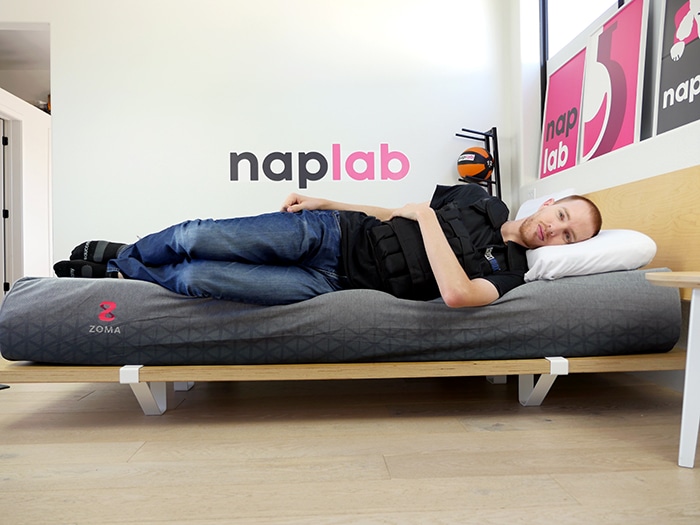
Side sleepers and heavier sleepers sink more deeply into the mattress. In the case of the Zoma Start, that means you’re sinking quickly through the top 2.0” comfort layer and into the harder more supportive base foam.
While that support is indeed supportive, it doesn’t have the right mix of pressure relief, comfort, and transitional support to support bodies without creating pressure points.
For these reasons, I feel that the Zoma Start is best for back and stomach sleepers, as well as lighter weight sleepers.
Many side sleepers, moderate-weight bodies, and heavy bodies are likely going to be better off with a different mattress.
| Sleeper Weight | Stomach Sleepers | Side Sleepers | Back Sleepers |
|---|---|---|---|
| Under 150 lbs. | Yes | Yes | Yes |
| 150-250 lbs. | Yes | Maybe | Yes |
| 250-300 lbs. | Maybe | No | Maybe |
Design
The Zoma Start mattress is an all-foam mattress with a 10″ firmness and a medium-firm feel. It is designed as a budget-friendly option, especially for sleepers who don’t need the thicker comfort layer.
| Design Factor | Data |
|---|---|
| Type | Foam |
| Thickness | 10″ |
| Cover Type | Thin |
| Weight | 70 lbs. |
| Has Handles | No |
| Fiberglass-Free | Yes |
| Ships in a Box | Yes |
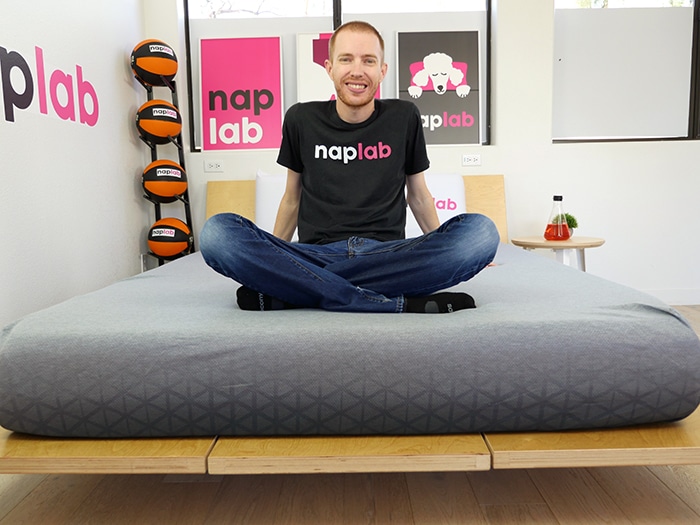
Materials
In total, the Zoma Start mattress is made up of three layers. From top to bottom, these layers include:
| Layer Type | Thickness | Layer Specs |
|---|---|---|
| Memory Foam | 1.0″ | 1.0 PCF, 10 ILD |
| Poly Foam | 1.0″ | 1.6 PCF, 20 ILD |
| Support Foam | 8.0″ | 1.6 PCF, 32 ILD |
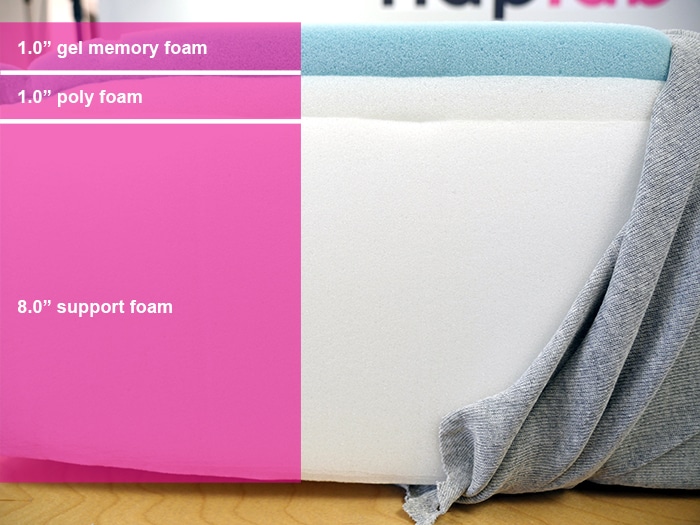
The Cover
The cover of the Zoma start is stretchy, lightweight, and breathable. It promotes cooling and allows the sleeper to quickly engage with the layers below, without providing excessive sinkage or contour.

The Comfort Layer
The comfort layer includes a 1.0″ layer of gel memory foam and a 1.0″ layer of transitional poly foam directly below.
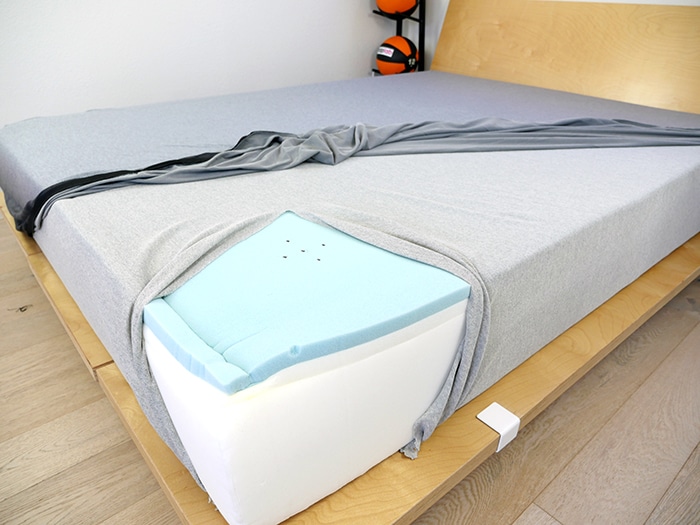
These two foams work together to provide comfort, ultra-fast response time, and pressure relief above the support layer.
The Support Layer
The support layer makes up 80% of the mattress thickness, which is a bit more than we typically see.
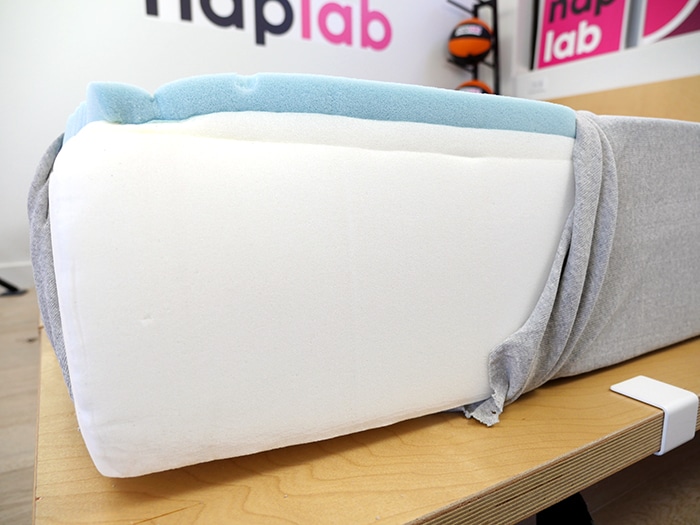
Product Evolution
The Zoma Start was included in the original lineup when the company was launched back in 2019. Since its launch, there have been no major changes to the design, feel, or firmness of this mattress.
Zoma Start vs. Zoma Hybrid
The Zoma Start vs. Zoma Hybrid compares the top-of-the-line Zoma to the budget Zoma so there are some big differences here.
The Zoma Hybrid has a support coil base while the Zoma Start relies on 100% foam support. The Hybrid also has 3″ of comfort material and the Start only has 2.0″. Because of this, the Start has a firmer feel than the Hybrid.
The Zoma Hybrid has lower motion transfer, less bounce, and also a slower response time compared to the Start.

Zoma Start
| Type: Foam |
| Thickness: 10″ |
| Firmness: Medium-Firm (6.5) |
| Price: $636(queen) |
| Overall Score: 8.56 |
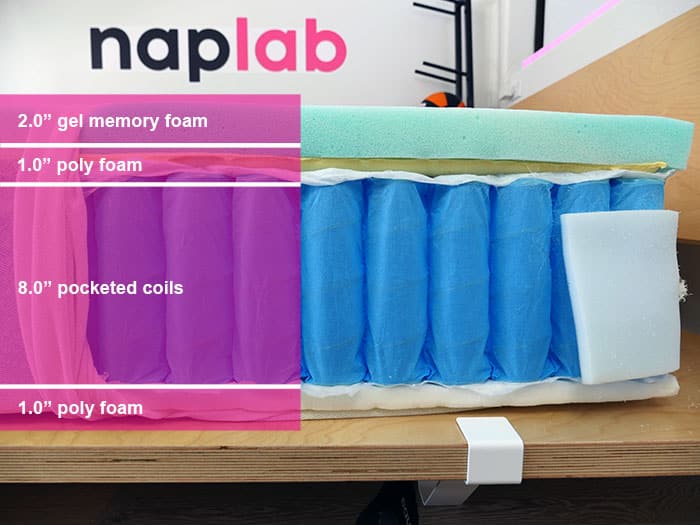
Zoma Hybrid
| Type: Hybrid |
| Thickness: 12″ |
| Firmness: Medium (5.0) |
| Price: $974 (queen) |
| Overall Score: 8.86 |
Other Mattresses to Consider
Not sure if the Zoma Start is the right mattress for you? Check out one of the other options below for a top-rated alternative.
For Motion Transfer

Ghostbed
Better Performance
The Ghostbed mattress is a 100% foam mattress, like the Start, but offers more restrained motion transfer and better transfer relief. But the trade-off is slightly worse edge support.
For Firmness
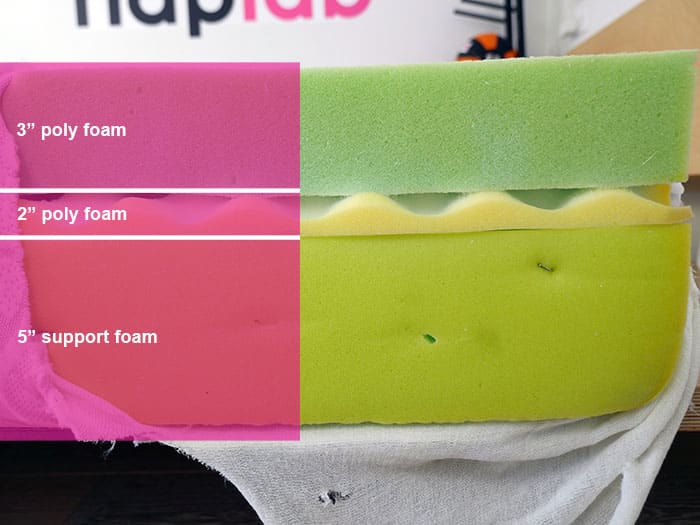
Nest Bedding Quail
2 Firmnesses Available
The Nest Bedding Quail mattress is a foam mattress that comes in a slightly softer firmness (5 out of 10) or a slightly firmer firmness (8 out of 10) compared to the Nest Bedding Quail. It also has a thicker comfort which is a plus for pressure relief.
For Cooling
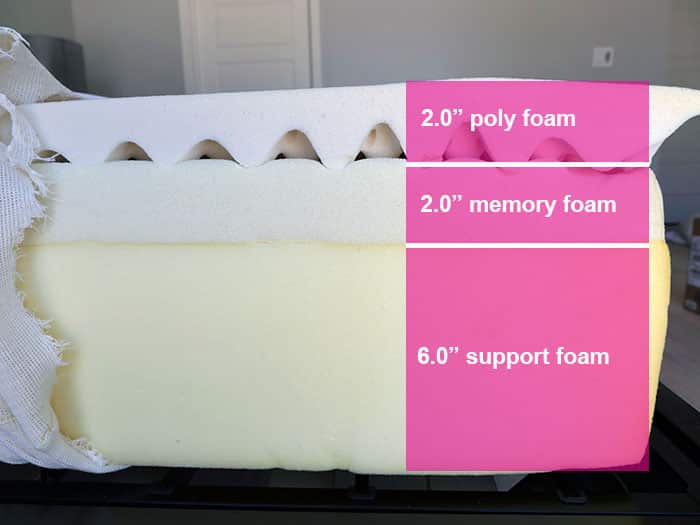
Leesa
Convoluted Foam
The Original Leesa has a 10″ high profile with 2.0″ poly foam, 2.0″ memory foam, and a 6.0″ support foam base. It has a balanced feel and slightly better cooling than the Zoma Start. It is also slightly softer (6 out of 10).
Frequently Asked Questions
Still have questions? Check out some of the top FAQs on the Zoma Start mattress below and get the answers you’re looking for.
Here are the current prices, with any sales or promotions reflected below:
Twin: $449
Twin XL: $524
Full: $561
Queen: $636
King: $824
Cal. King: $824
Split Cal. King: $1,048
*Note: Sales prices are subject to change without notice or warning.
All Zoma mattresses are made in the U.S. The company is based in Phoenix, AZ.
Zoma mattresses do not contain fiberglass.
Much like any other foam mattress, the Zoma takes just a few minutes to expand, although I always recommend giving it 12-24 hours to fully expand. If you want it to be fully off-gassed before sleeping on it, I’d wait around 3-4 days.
The materials and manufacturing of the Zoma mattress are certified by CertiPUR-US and contain no fiberglass, a known harmful material in mattress production.
While memory foam is not AS non-toxic as a natural or organic mattress, the chemicals used in memory foam production are MORE toxic during fabrication than they are as a fully assembled mattress.
Non-toxic: natural or organic mattress
Less toxic: finished memory foam mattress
More toxic: memory foam during the production



